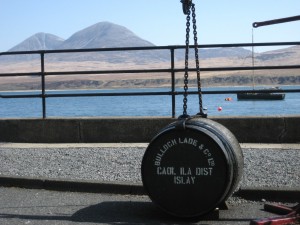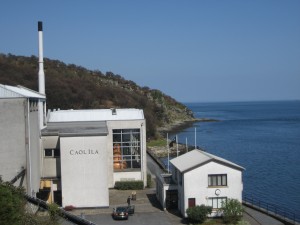Let me get this out of the way: Caol Ila has the best location for a distillery I’ve ever seen. Are there others I’ve yet to see that could be better? Perhaps. If something can top Caol Ila, I look forward to it. Let me also get this out of the way: Caol Ila’s actual distillery benefits greatly from the location.
The distillery is tucked at the base of imposing cliffs with a waterfall funneling its way through the forested cliff face. As impressive as that is, the other side of the distillery is breathtaking. Without the fast rushing waters of the Sound of Islay on its front door and the majestic Paps of Jura towering across the way, the distillery would be little more than an industrial spirits production facility. That’s not a very romantic description, though appropriate. What makes the entire experience romantic is looking past the massive stills and through the enormous windows to see a sailboat slipping through the Sound.
Caol Ila is deceptive in another way as well. Like its Islay cousin Lagavulin, Caol Ila’s barley is malted with a 35ppm peat level. The finished product lacks the huge punch of Lagavulin and instead offers a passionate kiss of peatiness that follows the sweet caress the spirit delivers.
Two factors contribute significantly to Caol Ila’s sweet spirit. The first is clear wort that comes off the mash tun, which has a three wash cycle. The second factor is the extremely long fermentation in the distillery’s larch washbacks. Caol Ila has a 110 hour fermentation process, which is double the length of fermentation for numerous distilleries. The longer fermentation allows the yeast to suck every last ounce of sugar out of the wort and gives a nice contrast to the peatiness imparted by the barley.
That sweet and smoky flavor profile also has strong hints of the sea, which is also a bit of a game of smoke and mirrors. The distillery only has room for 7,000 casks on-site, and most of those are older stocks. All new spirit is shipped to the mainland to be casked. So, let those arguments about whether or not salty sea air influences the flavor of whisky continue. Personally, I think it does, but I can also taste the sea in Caol Ila. Who knows: with all those years on the Pacific Ocean in L.A., maybe I’m the one who is infused with sea salt.
The bulk of Caol Ila’s 2.3 million liters produced each year goes toward Diageo’s Johnnie Walker blends. The remaining goes toward its core range of 12 and 18 year old expressions, as well as some of the limited bottlings, such as an 8-year-old unpeated edition, un-aged cask strength, 12-year-old Distiller’s edition matured in a Muscatel cask for six months and a 25-year-old limited edition.
My cottage was located 20 minutes from Caol Ila, through fields and across burns. I would often walk past the distillery to spend time sitting along the rocky shore, downwind of the distillery, soaking in the rich barley aromas. Caol Ila produces a massive amount of whisky and its distillery is built for that purpose. For me, though, the whisky evokes memories of seals playing along the shore, a wealth of seabirds splashing in the waves and a smoky-sweet liquid crossing my lips as I enjoyed a rare sunny day on Islay in winter. Caol Ila is essentially my friendly neighborhood distillery. I encourage you to give it a try and maybe the dram will take you there, too.


